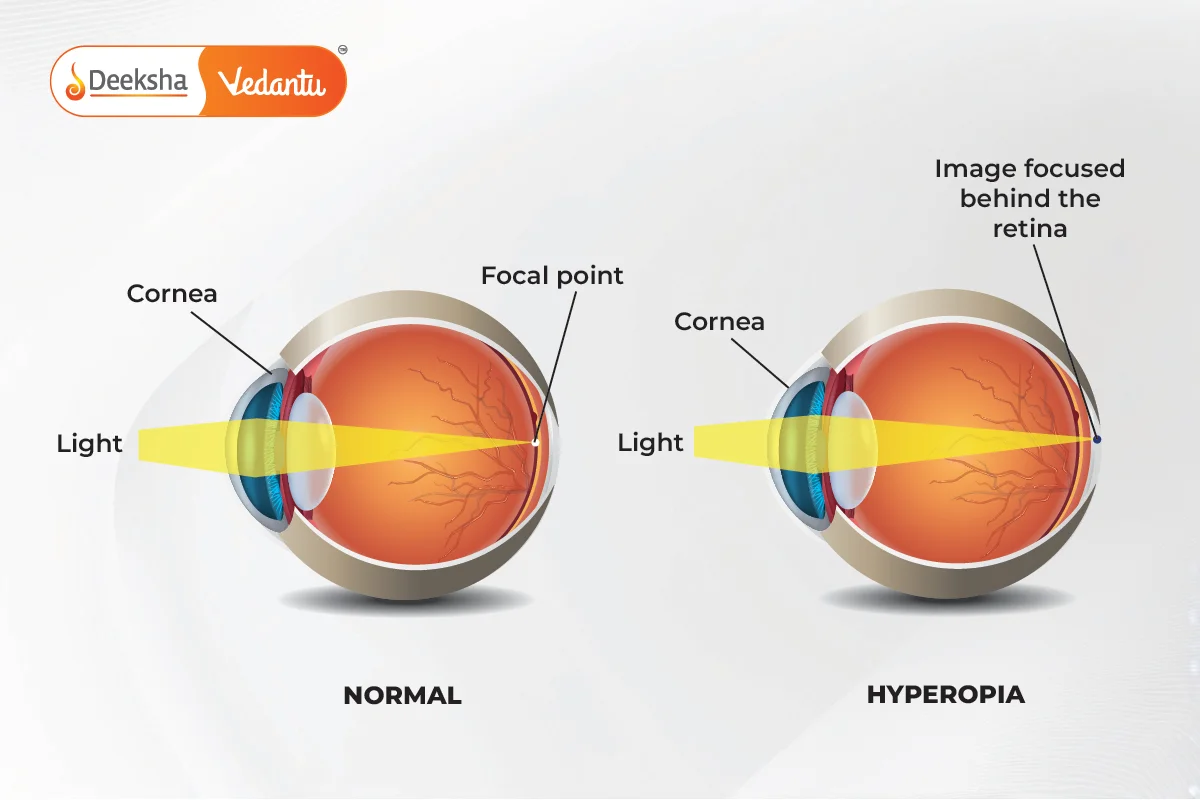Introduction
The human eye has a remarkable ability to focus light from objects at various distances, allowing us to see clearly. However, in some cases, the eye may develop defects that affect the proper focusing of light on the retina. These defects are known as refractive errors and can cause blurry vision. Fortunately, these defects can usually be corrected using lenses, surgery, or other treatments.
In this section, we will discuss the most common defects of vision—myopia, hypermetropia, presbyopia, and astigmatism – and explore how each can be corrected.
Myopia (Near-Sightedness)
Definition:
Myopia, or near-sightedness, is a common vision defect where a person can see nearby objects clearly but finds it difficult to see distant objects. In myopia, the eye focuses light in front of the retina, causing distant objects to appear blurry.

Causes of Myopia:
Myopia occurs due to one of the following reasons:
- Elongation of the eyeball: The distance between the lens and the retina is too large, causing the image to form in front of the retina.
- Excessive curvature of the cornea or lens: The cornea or lens is too curved, causing light to converge before reaching the retina.
How Myopia Affects Vision:
- Objects that are near (like a book or mobile phone) appear clear because the light rays from these objects focus correctly on the retina.
- Objects that are far away (like a distant building or a road sign) appear blurry because the light rays converge before they reach the retina.
Correction of Myopia:
Myopia is corrected using concave lenses. These lenses diverge the light rays entering the eye, causing them to spread out slightly before they reach the eye. This shifts the focus of the light back onto the retina, allowing distant objects to be seen clearly.
Key Formula:
The power of the corrective lens is given by:
Where:
= power of the lens in dioptres,
= focal length in meters (negative for concave lenses).
Example: A person with a myopic eye has a far point of 2 meters. The power of the concave lens required is:
The negative sign indicates that the lens is concave.
Diagram of Correction:

Real-Life Example:
Many people who wear glasses from a young age often suffer from myopia. When they take off their glasses, they can read books and look at objects nearby but find it hard to see distant objects like road signs or people far away.
Hypermetropia (Far-Sightedness)
Definition:
Hypermetropia, or far-sightedness, is a vision defect where a person can see distant objects clearly but has difficulty focusing on nearby objects. In hypermetropia, the eye focuses light behind the retina, causing nearby objects to appear blurry.

Causes of Hypermetropia:
Hypermetropia occurs due to one of the following reasons:
- Shortened eyeball: The distance between the lens and the retina is too short, causing light to focus behind the retina.
- Flat cornea or lens: The curvature of the cornea or lens is too flat, preventing the eye from converging light properly.
How Hypermetropia Affects Vision:
- Distant objects (like a person standing far away) appear clear because light rays from these objects focus correctly on the retina.
- Nearby objects (like a book or mobile phone) appear blurry because the light rays focus behind the retina.
Correction of Hypermetropia:
Hypermetropia is corrected using convex lenses. Convex lenses converge the light rays before they enter the eye, bringing the focus forward onto the retina.
Key Formula:
The power of the convex lens required to correct hypermetropia is calculated using:
Where:
= power of the lens in dioptres,
= focal length in meters (negative for concave lenses).
Example: A person has a near point of 50 cm. The power of the convex lens required is:
Diagram of Correction:

Real-Life Example:
Older adults often suffer from hypermetropia, which makes it difficult for them to read books or newspapers. They use reading glasses with convex lenses to correct this defect.
Presbyopia
Definition:
Presbyopia is an age-related vision defect in which the eye gradually loses its ability to focus on nearby objects due to the weakening of the ciliary muscles and the loss of elasticity in the lens. It typically affects people over the age of 40.

Causes of Presbyopia:
- Aging of the eye lens: Over time, the lens becomes less flexible and harder, making it difficult to change shape and focus on nearby objects.
- Weakening of the ciliary muscles: The ciliary muscles, which control the curvature of the lens, weaken with age, reducing their ability to adjust the lens for near vision.
How Presbyopia Affects Vision:
- People with presbyopia find it difficult to focus on nearby objects, such as reading material, but they can still see distant objects clearly.
- This condition is often described as a combination of both myopia and hypermetropia, especially in older adults.
Correction of Presbyopia:
Presbyopia is corrected using bifocal lenses or progressive lenses. Bifocal lenses have two different focal lengths:
- The upper part of the lens is for distance vision (corrects hypermetropia).
- The lower part is for near vision (corrects presbyopia).
Real-Life Example:
People over 40 often experience difficulty reading fine print or focusing on nearby objects. They may need bifocal glasses, which allow them to see both near and far objects clearly.
Astigmatism
Definition:
Astigmatism is a vision defect in which the cornea or lens has an irregular curvature, causing light to focus at multiple points on the retina. This results in blurred or distorted vision for both near and distant objects.

Causes of Astigmatism:
- Irregularly shaped cornea or lens: Instead of being spherical, the cornea or lens may have a more elliptical shape, which causes light to focus unevenly on the retina.
How Astigmatism Affects Vision:
- People with astigmatism experience blurred or distorted vision at all distances because light is not focused at a single point on the retina.
- Vertical and horizontal lines may appear out of focus or distorted.
Correction of Astigmatism:
Astigmatism is corrected using cylindrical lenses, which have different curvatures in different directions. These lenses correct the uneven focusing of light, allowing the eye to form a clear image on the retina.
Real-Life Example:
People with astigmatism often have difficulty reading or focusing on objects at any distance. Their glasses or contact lenses are specially designed to correct the uneven curvature of the cornea or lens.
Practice Questions with Answers
Q1: What causes myopia, and how can it be corrected?
- Answer: Myopia is caused by an elongated eyeball or an excessively curved cornea, which causes light to focus in front of the retina. It can be corrected using concave lenses, which diverge the light rays and bring the focus onto the retina.
Q2: Explain the difference between hypermetropia and presbyopia.
- Answer: Hypermetropia is a defect where a person has difficulty focusing on nearby objects due to a short eyeball or a flat cornea. Presbyopia is an age-related condition where the lens loses its flexibility, making it difficult to focus on nearby objects. Hypermetropia can occur at any age, while presbyopia typically affects older adults.
Q3: How does a convex lens correct hypermetropia?
- Answer: A convex lens converges the light rays before they enter the eye, shifting the focus forward onto the retina, allowing nearby objects to be seen clearly.
Q4: What is astigmatism, and how can it be corrected?
- Answer: Astigmatism is a defect caused by an irregularly shaped cornea or lens, leading to blurred vision because light focuses at multiple points on the retina. It can be corrected using cylindrical lenses, which correct the uneven focusing of light.
Q5: Why do older people often need bifocal lenses?
- Answer: Older people often suffer from presbyopia, an age-related defect that makes it difficult to focus on nearby objects. Bifocal lenses have two parts: one for near vision and one for distance vision, allowing them to see both near and distant objects clearly.
FAQs
Laser surgery, such as LASIK, reshapes the cornea to correct its curvature, allowing light to focus correctly on the retina. This procedure can correct myopia, hypermetropia, and astigmatism, often eliminating the need for glasses or contact lenses.
Yes, astigmatism can occur alongside myopia or hypermetropia. In such cases, glasses or contact lenses can be designed to correct both defects simultaneously.
Spherical lenses (concave and convex) are used to correct simple vision defects like myopia and hypermetropia. Cylindrical lenses are used to correct astigmatism, as they focus light differently along different axes to correct irregularities in the curvature of the cornea or lens.












Get Social